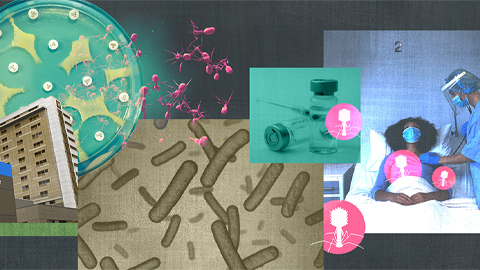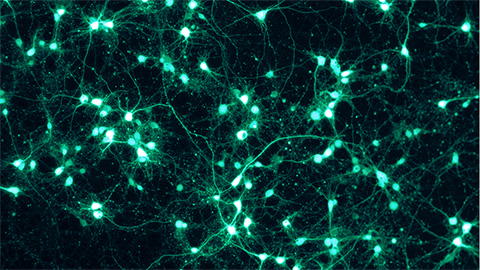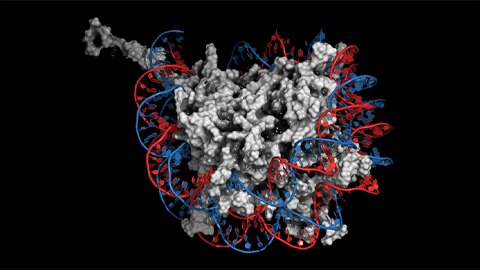Mechanism may influence infectivity of SARS-CoV-2 variants
Scientists at the National Institutes of Health have found that a process in cells may limit infectivity of SARS-CoV-2, and that mutations in the alpha and delta variants overcome this effect, potentially boosting the virus’s ability to spread. The findings were published online in the Proceedings of the National Academy of Sciences. The study was led by Kelly Ten Hagen, a senior investigator at NIH’s National Institute of Dental and Craniofacial Research.
Since the coronavirus pandemic began in early 2020, several more-infectious variants of SARS-CoV-2, the virus that causes COVID-19, have emerged. The original, or wild-type, virus was followed by the alpha variant, which became widespread in the United States in early 2021, and the delta variant, which is the most prevalent strain circulating today. The variants have acquired mutations that help them spread and infect people more easily. Many of the mutations affect the spike protein, which the virus uses to get into cells. Scientists have been trying to understand how these changes alter the virus’ function.

“Throughout the pandemic, NIDCR researchers have applied their expertise in the oral health sciences to answer key questions about COVID-19,” said NIDCR Director Rena D’Souza, D.D.S., Ph.D. “This study offers fresh insights into the greater infectivity of the alpha and delta variants and provides a framework for the development of future therapies.”
The outer surface of SARS-CoV-2 is decorated with spike proteins, which the virus uses to attach to and enter cells. Before this can happen, though, the spike protein must be activated by a series of cuts, or cleavages, by host proteins, starting with the furin enzyme. In the alpha and delta variants, mutations to the spike protein appear to enhance furin cleavage, which is thought to make the virus more effective at entering cells.
Studies have shown that in some cases protein cleavage can be decreased by the addition of bulky sugar molecules—a process carried out by enzymes called GALNTs — next to the cleavage site. Ten Hagen’s team wondered if this happens to the SARS-CoV-2 spike protein, and if so, whether it changes the protein’s function.
To find out, the scientists studied the effects of GALNT activity on spike protein in fruit fly and mammalian cells. The experiments showed that one enzyme, GALNT1, adds sugars to wild-type spike protein, and this activity reduces furin cleavage. By contrast, mutations to the spike protein, like those in the alpha and delta variants, decrease GALNT1 activity and increase furin cleavage. This suggested that GALNT1 activity may partially suppress furin cleavage in wild-type virus, and that the alpha and delta mutations overcome this effect, allowing furin cleavage to go unchecked.
Further experiments supported this idea. The researchers expressed either wild-type or mutated spike in cells grown in a dish. They observed the cells’ tendency to fuse with their neighbors, a behavior that may facilitate spread of the virus during infection. The scientists found that cells expressing mutated spike protein fused with neighbors more often than cells with the wild-type version. Cells with wild-type spike also fused less in the presence of GALNT1, suggesting that its activity may limit spike protein function.
“Our findings indicate that the alpha and delta mutations overcome the dampening effect of GALNT1 activity, which may enhance the virus’s ability to get into cells,” said Ten Hagen.
To see if this process might also occur in people, the team analyzed RNA expression in cells from healthy volunteers. The researchers found wide expression of GALNT1 in lower and upper respiratory tract cells that are susceptible to SARS-CoV-2 infection, indicating that the enzyme could influence infection in humans. The scientists theorized that individual differences in GALNT1 expression could affect viral spread.
“This study suggests that GALNT1 activity may modulate viral infectivity and provides insight into how mutations in the alpha and delta variants may influence this,” Ten Hagen said. The knowledge could inform future efforts to develop new interventions.
This research was supported by the NIDCR Division of Intramural Research. Support also came from the intramural program of the National Institute of Environmental Health Sciences.
Enjoy reading ASBMB Today?
Become a member to receive the print edition four times a year and the digital edition weekly.
Learn moreGet the latest from ASBMB Today
Enter your email address, and we’ll send you a weekly email with recent articles, interviews and more.
Latest in Science
Science highlights or most popular articles

What if a virus could reverse antibiotic resistance?
In promising experiments, phage therapy forces bacteria into a no-win dilemma that lowers their defenses against drugs they’d evolved to withstand.

Tapping into bacterial conversations
Bonnie Bassler has helped usher in a new branch of science centered on quorum sensing, the process by which bacteria communicate with one another and orchestrate collective tasks.

From the journals: JLR
Can diacylglycerol combat athlete hyperuricemia? Inhibiting a cardiac enzyme improves metabolism. Targeting angiopoietins to combat liver injury. Read about papers on these topics recently published in the Journal of Lipid Research.

Liver enzyme holds key to adjusting to high-protein diets
Researchers at the University of Geneva show that glutamate dehydrogenase controls blood alkalinity during fasting.

Adults grow new brain cells
How does the rare birth of these new neurons contribute to cognitive function?

From the journals: JBC
Histone demethylase inhibited by own sequence. MicroRNA reduces cell cycle–related apoptosis. Multipurpose antibiotic takes on staph infections. Read about recent JBC papers on these topics.

